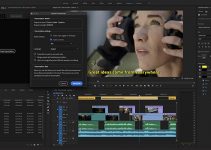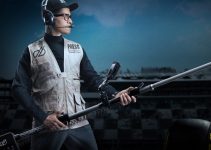The GH4 is proving to be a massive hit with the independent filmmaking community and day in and day out we see beautiful 4K and HD footage shot with the new Panasonic mirrorless camera.
Some shooters are electing to use it as their main A-camera, where others are finding some very creative ways to implement the GH4 into their existing workflow environment and kit.
Footage from the Panasonic camera can be intercut with other large sensor cameras like the Canon C100 and the C300, which have been around for a while and have found a home with corporate, documentary, and promo shooters.
Depending on your skills level as a cameraman, colourist and editor, 4K or 1080p footage from the GH4 can be matched almost seamlessly with most other cameras.
In this post we’ll share a very nice video and a great write up by Nicos Argillet, a freelance video journalist and director based in Paris and Reykjavik. You can check out his work on Vimeo here.
A GH4 IN THE FIELD – C300/C100 INTERCUT from Nicos A. on Vimeo.
Nicos used the GH4 recently on a documentary shoot for French broadcaster – France 5 in Georgia, in the Caucasus region. Testing a piece of kit is best done in a real-world production environment, and he was able to achieve excellent results intercutting the C100/C300 footage he shot there with the that from the GH4.
Here’s are Nicos’ findings in his own words below.
- All shots were only slightly graded in Premiere CS6 using the basic color correction tools to match exposure and roughly set the black/white/saturation levels.
- All C300/C100 shots are C-Log.
- All GH4 shots use the Neutral profile with sharpness and noise reduction set to -5, contrast and saturation between -3 and -5, depending on the scene.
- Master Pedestral was set to +10. This is the profile that work best for me after doing some test during my first week.
- I didn’t try to match the tints as I wanted to check the results «out of the camera», sort of.
- Note that the GH4 had a Schneider True Match Vari ND in front of the lens, so that may give it a twist.
So, What did he learn from his GH4 experience?
Looking at the landscape shots from the GH4, I have to say that I am pretty impress with the results. Shooting in 4k and editing on a 1080p timeline gives a pretty close match in terms of resolution and a very nice rendering to my taste. On the dynamic range side, the GH4 is definitely not as good as the Canon cameras. It maybe not completely obvious of those scenes but the GH4 just can’t handle as much difference between highlights and shadows.
The reason for that is the noise level. All shots on the C300 where done between 850 and 1600 ISO when the GH4 was set to 200 ISO. To my eyes, the noise of the GH4 is as visible at that setting as 1600 ISO on the C300. The other thing I noticed is that the GH4 can be very noisy on the dark part of the image. When for instance shooting a mountain top with a forest below, setting the exposure to protect the sky, the forest, although clearly visible, would become really noisy. Even though it seemed to capture those dark stops, it was capturing it with a lot of noise.
For me it means that protecting the highlights and underexposing like you could do on a C300 is problematic on the GH4 as the grade would bring too much noise. For the same reason I think that trying to increase dynamic range with picture profiles will only show noisier shadows.
On the other side, the GH4 has some great tools that the C300 does not. It can do time lapses straight in camera, which is a big time saver and a very cool feature ! I used that feature a lot during our shooting (only one shot in this edit) and I am very pleased not to have to bring another photo camera just for those. On the C300 the under-crank is just rubbish.The GH4 also has very cool slow-motion possibilities. I didn’t use those during this shooting because it wouldn’t match our story. But for music videos, shorts and more creative shooting, that is definitely a plus.
Technical limitations asides, the GH4 proved to be a really great tool for our shooting environment.
When shooting abroad in remote areas, we usually take with us a C300 as our A camera and a C100 as a B camera. But when conditions of shooting imply long hiking sessions or when battery life becomes more important than IQ, the C300 just stays home and the C100 becomes the A camera. It’s in those situations that I was really hopping the GH4 could be a good sidekick. It’s form factor, size, weight, battery life and media capacity just make it the perfect tool for those kind of jobs. With only a battery grip, a vari ND and a reference mic, I was able to shoot all day in all conditions, even when riding a horse !
On the other side the EVF is not as good as the one on the C300, the screen is not very bright, but who cares ? It gets the job done ! The ability to set a free-run timecode alone is a big time saver in post production.
But the real test was to see how well I could match the Canon cameras and the GH4.
Looking at the two cameras side by side, and especially the interview parts, I think that they intercut nicely, even with minimum post-production. And for me this is the most important.In the end, the GH4 maybe not be the perfect camera but the C300 and C100 aren’t either. What matters is how effective it can be on the field. How it can help us tell stories, be more responsive and travel lighter.
Here’s a list of the gear he used to film this piece:
GH4
Panasonic 12-35
Schneider True-Match Vari ND 77mm
Cordvision 58-77 adapter
C300 & C100
EF 17-55
EF 70-300 L
EF 24-105 L
C300 & GH4 operated by Nicos A.
C100 operated by Manuel Lgr
Check out his other video with the GH4 here:
One week with the GH4 from Nicos A. on Vimeo.
[via Nicos Argillet on Vimeo]
Disclaimer: As an Amazon Associate partner and participant in B&H and Adorama Affiliate programmes, we earn a small comission from each purchase made through the affiliate links listed above at no additional cost to you.



